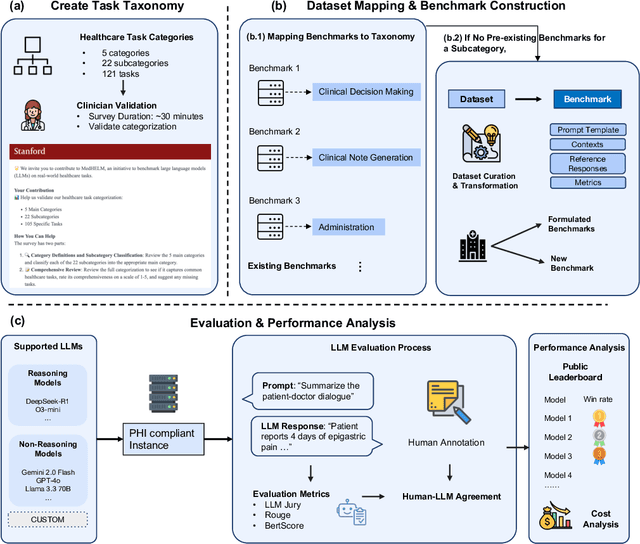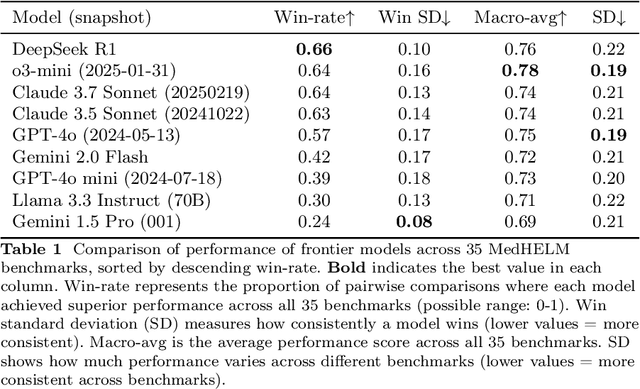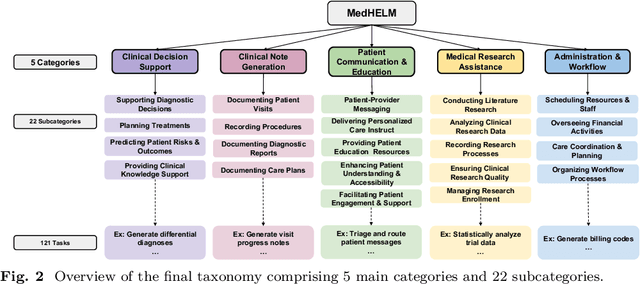Hejie Cui
KERAP: A Knowledge-Enhanced Reasoning Approach for Accurate Zero-shot Diagnosis Prediction Using Multi-agent LLMs
Jul 03, 2025



Abstract:Medical diagnosis prediction plays a critical role in disease detection and personalized healthcare. While machine learning (ML) models have been widely adopted for this task, their reliance on supervised training limits their ability to generalize to unseen cases, particularly given the high cost of acquiring large, labeled datasets. Large language models (LLMs) have shown promise in leveraging language abilities and biomedical knowledge for diagnosis prediction. However, they often suffer from hallucinations, lack structured medical reasoning, and produce useless outputs. To address these challenges, we propose KERAP, a knowledge graph (KG)-enhanced reasoning approach that improves LLM-based diagnosis prediction through a multi-agent architecture. Our framework consists of a linkage agent for attribute mapping, a retrieval agent for structured knowledge extraction, and a prediction agent that iteratively refines diagnosis predictions. Experimental results demonstrate that KERAP enhances diagnostic reliability efficiently, offering a scalable and interpretable solution for zero-shot medical diagnosis prediction.
MedHELM: Holistic Evaluation of Large Language Models for Medical Tasks
May 26, 2025



Abstract:While large language models (LLMs) achieve near-perfect scores on medical licensing exams, these evaluations inadequately reflect the complexity and diversity of real-world clinical practice. We introduce MedHELM, an extensible evaluation framework for assessing LLM performance for medical tasks with three key contributions. First, a clinician-validated taxonomy spanning 5 categories, 22 subcategories, and 121 tasks developed with 29 clinicians. Second, a comprehensive benchmark suite comprising 35 benchmarks (17 existing, 18 newly formulated) providing complete coverage of all categories and subcategories in the taxonomy. Third, a systematic comparison of LLMs with improved evaluation methods (using an LLM-jury) and a cost-performance analysis. Evaluation of 9 frontier LLMs, using the 35 benchmarks, revealed significant performance variation. Advanced reasoning models (DeepSeek R1: 66% win-rate; o3-mini: 64% win-rate) demonstrated superior performance, though Claude 3.5 Sonnet achieved comparable results at 40% lower estimated computational cost. On a normalized accuracy scale (0-1), most models performed strongly in Clinical Note Generation (0.73-0.85) and Patient Communication & Education (0.78-0.83), moderately in Medical Research Assistance (0.65-0.75), and generally lower in Clinical Decision Support (0.56-0.72) and Administration & Workflow (0.53-0.63). Our LLM-jury evaluation method achieved good agreement with clinician ratings (ICC = 0.47), surpassing both average clinician-clinician agreement (ICC = 0.43) and automated baselines including ROUGE-L (0.36) and BERTScore-F1 (0.44). Claude 3.5 Sonnet achieved comparable performance to top models at lower estimated cost. These findings highlight the importance of real-world, task-specific evaluation for medical use of LLMs and provides an open source framework to enable this.
Data Foundations for Large Scale Multimodal Clinical Foundation Models
Mar 09, 2025Abstract:Recent advances in clinical AI have enabled remarkable progress across many clinical domains. However, existing benchmarks and models are primarily limited to a small set of modalities and tasks, which hinders the development of large-scale multimodal methods that can make holistic assessments of patient health and well-being. To bridge this gap, we introduce Clinical Large-Scale Integrative Multimodal Benchmark (CLIMB), a comprehensive clinical benchmark unifying diverse clinical data across imaging, language, temporal, and graph modalities. CLIMB comprises 4.51 million patient samples totaling 19.01 terabytes distributed across 2D imaging, 3D video, time series, graphs, and multimodal data. Through extensive empirical evaluation, we demonstrate that multitask pretraining significantly improves performance on understudied domains, achieving up to 29% improvement in ultrasound and 23% in ECG analysis over single-task learning. Pretraining on CLIMB also effectively improves models' generalization capability to new tasks, and strong unimodal encoder performance translates well to multimodal performance when paired with task-appropriate fusion strategies. Our findings provide a foundation for new architecture designs and pretraining strategies to advance clinical AI research. Code is released at https://github.com/DDVD233/climb.
TIMER: Temporal Instruction Modeling and Evaluation for Longitudinal Clinical Records
Mar 06, 2025Abstract:Large language models (LLMs) have emerged as promising tools for assisting in medical tasks, yet processing Electronic Health Records (EHRs) presents unique challenges due to their longitudinal nature. While LLMs' capabilities to perform medical tasks continue to improve, their ability to reason over temporal dependencies across multiple patient visits and time frames remains unexplored. We introduce TIMER (Temporal Instruction Modeling and Evaluation for Longitudinal Clinical Records), a framework that incorporate instruction-response pairs grounding to different parts of a patient's record as a critical dimension in both instruction evaluation and tuning for longitudinal clinical records. We develop TIMER-Bench, the first time-aware benchmark that evaluates temporal reasoning capabilities over longitudinal EHRs, as well as TIMER-Instruct, an instruction-tuning methodology for LLMs to learn reasoning over time. We demonstrate that models fine-tuned with TIMER-Instruct improve performance by 7.3% on human-generated benchmarks and 9.2% on TIMER-Bench, indicating that temporal instruction-tuning improves model performance for reasoning over EHR.
Biomedical Visual Instruction Tuning with Clinician Preference Alignment
Jun 19, 2024



Abstract:Recent advancements in multimodal foundation models have showcased impressive capabilities in understanding and reasoning with visual and textual information. Adapting these foundation models trained for general usage to specialized domains like biomedicine requires large-scale domain-specific instruction datasets. While existing works have explored curating such datasets automatically, the resultant datasets are not explicitly aligned with domain expertise. In this work, we propose a data-centric framework, Biomedical Visual Instruction Tuning with Clinician Preference Alignment (BioMed-VITAL), that incorporates clinician preferences into both stages of generating and selecting instruction data for tuning biomedical multimodal foundation models. First, during the generation stage, we prompt the GPT-4V generator with a diverse set of clinician-selected demonstrations for preference-aligned data candidate generation. Then, during the selection phase, we train a separate selection model, which explicitly distills clinician and policy-guided model preferences into a rating function to select high-quality data for medical instruction tuning. Results show that the model tuned with the instruction-following data from our method demonstrates a significant improvement in open visual chat (18.5% relatively) and medical VQA (win rate up to 81.73%). Our instruction-following data and models are available at BioMed-VITAL.github.io.
TACCO: Task-guided Co-clustering of Clinical Concepts and Patient Visits for Disease Subtyping based on EHR Data
Jun 14, 2024



Abstract:The growing availability of well-organized Electronic Health Records (EHR) data has enabled the development of various machine learning models towards disease risk prediction. However, existing risk prediction methods overlook the heterogeneity of complex diseases, failing to model the potential disease subtypes regarding their corresponding patient visits and clinical concept subgroups. In this work, we introduce TACCO, a novel framework that jointly discovers clusters of clinical concepts and patient visits based on a hypergraph modeling of EHR data. Specifically, we develop a novel self-supervised co-clustering framework that can be guided by the risk prediction task of specific diseases. Furthermore, we enhance the hypergraph model of EHR data with textual embeddings and enforce the alignment between the clusters of clinical concepts and patient visits through a contrastive objective. Comprehensive experiments conducted on the public MIMIC-III dataset and Emory internal CRADLE dataset over the downstream clinical tasks of phenotype classification and cardiovascular risk prediction demonstrate an average 31.25% performance improvement compared to traditional ML baselines and a 5.26% improvement on top of the vanilla hypergraph model without our co-clustering mechanism. In-depth model analysis, clustering results analysis, and clinical case studies further validate the improved utilities and insightful interpretations delivered by TACCO. Code is available at https://github.com/PericlesHat/TACCO.
LLMs-based Few-Shot Disease Predictions using EHR: A Novel Approach Combining Predictive Agent Reasoning and Critical Agent Instruction
Mar 19, 2024Abstract:Electronic health records (EHRs) contain valuable patient data for health-related prediction tasks, such as disease prediction. Traditional approaches rely on supervised learning methods that require large labeled datasets, which can be expensive and challenging to obtain. In this study, we investigate the feasibility of applying Large Language Models (LLMs) to convert structured patient visit data (e.g., diagnoses, labs, prescriptions) into natural language narratives. We evaluate the zero-shot and few-shot performance of LLMs using various EHR-prediction-oriented prompting strategies. Furthermore, we propose a novel approach that utilizes LLM agents with different roles: a predictor agent that makes predictions and generates reasoning processes and a critic agent that analyzes incorrect predictions and provides guidance for improving the reasoning of the predictor agent. Our results demonstrate that with the proposed approach, LLMs can achieve decent few-shot performance compared to traditional supervised learning methods in EHR-based disease predictions, suggesting its potential for health-oriented applications.
Microstructures and Accuracy of Graph Recall by Large Language Models
Feb 20, 2024



Abstract:Graphs data is crucial for many applications, and much of it exists in the relations described in textual format. As a result, being able to accurately recall and encode a graph described in earlier text is a basic yet pivotal ability that LLMs need to demonstrate if they are to perform reasoning tasks that involve graph-structured information. Human performance at graph recall has been studied by cognitive scientists for decades, and has been found to often exhibit certain structural patterns of bias that align with human handling of social relationships. To date, however, we know little about how LLMs behave in analogous graph recall tasks: do their recalled graphs also exhibit certain biased patterns, and if so, how do they compare with humans and affect other graph reasoning tasks? In this work, we perform the first systematical study of graph recall by LLMs, investigating the accuracy and biased microstructures (local structural patterns) in their recall. We find that LLMs not only underperform often in graph recall, but also tend to favor more triangles and alternating 2-paths. Moreover, we find that more advanced LLMs have a striking dependence on the domain that a real-world graph comes from -- by yielding the best recall accuracy when the graph is narrated in a language style consistent with its original domain.
Knowledge-Infused Prompting: Assessing and Advancing Clinical Text Data Generation with Large Language Models
Nov 01, 2023



Abstract:Clinical natural language processing requires methods that can address domain-specific challenges, such as complex medical terminology and clinical contexts. Recently, large language models (LLMs) have shown promise in this domain. Yet, their direct deployment can lead to privacy issues and are constrained by resources. To address this challenge, we delve into synthetic clinical text generation using LLMs for clinical NLP tasks. We propose an innovative, resource-efficient approach, ClinGen, which infuses knowledge into the process. Our model involves clinical knowledge extraction and context-informed LLM prompting. Both clinical topics and writing styles are drawn from external domain-specific knowledge graphs and LLMs to guide data generation. Our extensive empirical study across 7 clinical NLP tasks and 16 datasets reveals that ClinGen consistently enhances performance across various tasks, effectively aligning the distribution of real datasets and significantly enriching the diversity of generated training instances. We will publish our code and all the generated data in \url{https://github.com/ritaranx/ClinGen}.
Open Visual Knowledge Extraction via Relation-Oriented Multimodality Model Prompting
Oct 28, 2023



Abstract:Images contain rich relational knowledge that can help machines understand the world. Existing methods on visual knowledge extraction often rely on the pre-defined format (e.g., sub-verb-obj tuples) or vocabulary (e.g., relation types), restricting the expressiveness of the extracted knowledge. In this work, we take a first exploration to a new paradigm of open visual knowledge extraction. To achieve this, we present OpenVik which consists of an open relational region detector to detect regions potentially containing relational knowledge and a visual knowledge generator that generates format-free knowledge by prompting the large multimodality model with the detected region of interest. We also explore two data enhancement techniques for diversifying the generated format-free visual knowledge. Extensive knowledge quality evaluations highlight the correctness and uniqueness of the extracted open visual knowledge by OpenVik. Moreover, integrating our extracted knowledge across various visual reasoning applications shows consistent improvements, indicating the real-world applicability of OpenVik.
 Add to Chrome
Add to Chrome Add to Firefox
Add to Firefox Add to Edge
Add to Edge